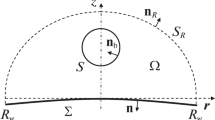Abstract
The ascend and evolution of an axisymmetric gas bubble are studied numerically using an inviscid incompressible potential flow model. The volume of the gas bubble varies adiabatically. The transition from a simply connected bubble to a doubly connected toroidal one and its interaction with the free surface are simulated. The change in connectedness is accompanied by a nonzero velocity circulation and a discontinuous velocity potential occurring over an arbitrary toroidal liquid surface enclosing the bubble.
Similar content being viewed by others
References
L. V. Ovsyannikov, “Bubble rise,” in Certain Problems in Mathematics and Mechanics (Nauka, Leningrad, 1970) [in Russian].
M. A. Lavrent’ev and B. V. Shabat, Fluid Dynamics Problems and Their Mathematical Models (Nauka, Moscow, 1973) [in Russian].
O. V. Voinov and V. V. Voinov, “Numerical method for calculating inviscid incompressible unsteady flows with free surfaces,” Dokl. Akad. Nauk SSSR 221, 559–562 (1975).
A. Prosperetti, L. A. Crum, and K. W. Commander, “Nonlinear bubble dynamics,” J. Acoust. Soc. Am. 83, 502–514 (1998).
A. A. Aganin, L. A. Kosolapova, and V. G. Malakhov, “Nonlinear radial vibrations and displacements of a nonspherical gas bubble in liquid,” Mat. Model. 23(5), 56–70 (2011).
A. M. Gudov, “Numerical study of water surface phenomena in gas cavity collapse,” Vychisl. Tekhnol. 2(4), 49–59 (1997).
V. K. Kedrinskii, “Underwater explosion near free surface,” Dokl. Akad. Nauk SSSR 212, 324–326 (1973).
V. A. Korobitsyn, “Numerical modeling of axisymmetric potential flows of an incompressible fluid,” Mat. Model. 3(10), 42–49 (1991).
V. A. Korobitsyn and V. I. Pegov, “Numerical study of liquid-liquid interface evolution,” Izv. Ross. Akad. Nauk, Mekh. Zhidk. Gaza, No. 5, 128–133 (1993).
V. A. Korobitsyn, “Basis difference method for orthogonal systems on a surface,” Comput. Math. Math. Phys. 51, 1222–1230 (2011).
V. A. Korobitsyn, “Numerical modeling of multiply connected incompressible flows,” International Conference on Mathematical and Information Technologies for Science, Engineering, and Education, MIT2011, Vrnjacka Banja and Budva, August 27–September 5, 2011, pp. 94–95.
V. A. Korobitsyn, “Covariant transformations of basis differential-difference schemes in a plane,” Comput. Math. Math. Phys. 51, 1915–1922 (2011).
S. A. Beizel, L. B. Chubarov, D. Dutykh, et al., “Simulation of surface waves generated by an underwater landslide in a bounded reservoir,” Russ. J. Numer. Anal. Math. Model. 27, 539–558 (2013).
K. Lipnikov, G. Manzini, and M. Shashkov, “Mimetic finite difference method,” J. Comput. Phys. B, No. 257, 1163–1227 (2014).
V. A. Gasilov, V. M. Goloviznin, M. D. Taran, et al., Preprint No. 70, IPM AN SSSR (Keldysh Inst. of Applied Mathematics, USSR Academy of Sciences, Moscow, 1979).
R. T. Knapp, J. W. Daily, and F. G. Hammitt, Cavitation (McGraw-Hill, New York, 1970; Mir, Moscow, 1974).
A. Prosperetti and J. W. Jacobs, “A numerical method for potential flows with a free surface,” J. Comput. Phys. 51, 365–386 (1983).
V. V. Pukhnachev and V. A. Solonnikov, “On the dynamic contact angle,” Prikl. Mat. Mekh. 46(6) (1982).
C. W. Hirt, J. L. Cook, and T. D. Butler, “A Lagrangian method for calculating the dynamics of an incompressible fluid with free surface,” J. Comput. Phys. 5(2), 103–124 (1970).
Author information
Authors and Affiliations
Corresponding author
Additional information
Original Russian Text © A.M. Bubenchikov, V.A. Korobitsyn, D.V. Korobitsyn, P.P. Kotov, Yu.I. Shokin, 2014, published in Zhurnal Vychislitel’noi Matematiki i Matematicheskoi Fiziki, 2014, Vol. 54, No. 7, pp. 1194–1202.
Rights and permissions
About this article
Cite this article
Bubenchikov, A.M., Korobitsyn, V.A., Korobitsyn, D.V. et al. Numerical simulation of multiply connected axisymmetric discontinuous incompressible potential flows. Comput. Math. and Math. Phys. 54, 1167–1175 (2014). https://doi.org/10.1134/S0965542514070057
Received:
Accepted:
Published:
Issue Date:
DOI: https://doi.org/10.1134/S0965542514070057




